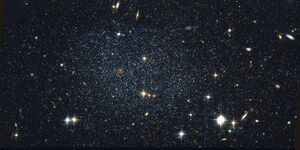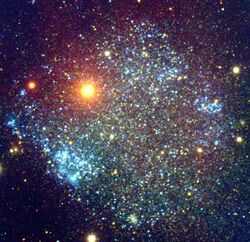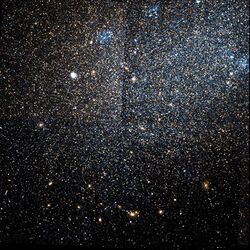Astronomy:Antlia-Sextans Group
The Antlia-Sextans Group is a small grouping of galaxies in the constellations Hydra, Sextans, Antlia and Leo. It is generally considered to be at the very edge of the Local Group and thus part of it. However, other researchers indicate it is an independent group, and thus the nearest group to the Local Group. It is, on average, approximately 4.3 million light-years away from the Milky Way.
Members
The Antlia-Sextans Group consists of the galaxies NGC 3109, Sextans A, Sextans B, Antlia Dwarf, Leo P and Antlia B. Leo A might also belong to the group, but this is considered unlikely.
NGC 3109
NGC 3109 is the largest and dominant member of this group, with a diameter of 41,700 light-years, almost half the diameter of the Milky Way.[1] It was the first discovered member of the group, discovered in 1835. It is also second closest to Earth, at a distance of 4.348 million light-years away. It was thought to be an irregular galaxy, but is now theorized to possibly be a barred spiral. It seems to be a galaxy with no central core. Based on spectroscopy of blue supergiants in NGC 3109, it is known that the galaxy has a low metallicity, similar to that to the Small Magellanic Cloud.[2] It is one of the most metal-poor galaxies in the Local group, if it is included.[3] NGC 3109 seems to contain an unusually large number of planetary nebulae for its luminosity.[4] It also contains a substantial amount of dark matter.[5]
From measurements of the neutral atomic hydrogen in the galaxy, it has been found that the disk of NGC 3109 is warped.[6]
Antlia Dwarf
Antlia Dwarf is the smallest and closest galaxy in the group, only 2,610 light-years in diameter at a distance of 4.305 million light-years.[7] The gas in the Antlia Dwarf galaxy has the same radial velocity as a warp in the disk of NGC 3109, indicating that the two galaxies had a close encounter approximately one billion years ago.[6]
Sextans A
Sextans A is 7,990 light-years in diameter, and square-shaped, and contains numerous star clusters, located at the distance of about 4.658 million light-years away.[8] Sextans A has a peculiar square shape. Massive short-lived stars exploded in supernovae that caused more star formation, triggering yet more supernovae, ultimately resulting in an expanding shell. Young blue stars now highlight areas and shell edges high in current star formation, which from the perspective of observers on Earth appears roughly square.[9] The 10.4m telescope Gran Telescopio Canarias recently observed the OB-type stars that power the giant HII regions.[10] Sextans A have formed a pair with the most remote galaxy in the group, Sextans B.
Sextans B
Sextans B is the second largest galaxy in the group, with a diameter of 8,900 light-years.[11] Sextans B is the most distant from Earth in the group, at 5.101 million light-years away.[11] Sextans B has a uniform stellar population,[12] but the interstellar medium in it may be inhomogeneous.[13] Its mass is estimated to be about 2 × 108 times the mass of the Sun, of which 5.5 × 107 is in the form of atomic hydrogen.[12] Star formation in the galaxy seems to have proceeded in distinct periods of low intensity, separated by shorter periods of no activity.[12] The existence of Cepheid variables in the galaxy implies that Sextans B contains at least some young stars.[14] The metallicity of Sextans B is rather low, with a value of approximately Z = 0.001.[12] Sextans B is receding from the Milky Way with a speed of approximately 300 kilometres per second (190 mi/s),[13] and probably lies just outside the edge of the Local Group, so as its neighbour Sextans A.[15]
Five planetary nebulae have been identified in Sextans B, which is one of the smallest galaxies where planetary nebulae have been observed. These appear point-like and can be identified by their spectral emission lines.[16] It also contains a massive globular cluster.[17]
Leo P
Leo P (AGC 208583 [18]) is a small irregular galaxy discovered in 2013. It is only 0.4 Mpc from the Sextans B, so it is considered as a member of this grouping. It is the most distant member of all, with a distance of 5.3 million light years.
Antlia B
Antlia B is recently discovered small galaxy. It is known to be a satellite of NGC 3109, and is similar to the Antlia Dwarf in many ways, and is transitioning from an irregular galaxy to a dwarf spheroidal.
| Name | Type[20] | R.A. (J2000)[20] | Dec. (J2000)[20] | Redshift (km/s)[20] | Apparent Magnitude[20] |
|---|---|---|---|---|---|
| NGC 3109 | SB(s)m | 10h 03m 06.9s | −26° 09′ 34″ | 403 ± 1 | 10.4 |
| Sextans A | IBm | 10h 11m 00.8s | −04° 41′ 34″ | 324 ± 2 | 11.9 |
| Sextans B | ImIV-V | 10h 00m 00.1s | +05° 19′ 56″ | 300 ± 0 | 11.9 |
| Antlia Dwarf | dSph/Irr | 10h 04m 03.9s | −27° 19′ 55″ | 362 ± 0 | 15.67 ± 0.02 |
| Leo P | Irr | 10h 21m 45.1s | +18° 05' 17" | N/A | 16.89 |
| Antlia B | N/A | N/A | N/A | N/A | N/A |
See also
References
- ↑ "Detailed Information for Object NGC 3109". NASA/IPAC Extragalactic Database. https://ned.ipac.caltech.edu/cgi-bin/objsearch?objname=NGC+3109&extend=no&hconst=67.74&omegam=0.3089&omegav=0.6911&corr_z=1&out_csys=Equatorial&out_equinox=J2000.0&obj_sort=RA+or+Longitude&of=pre_text&zv_breaker=30000.0&list_limit=5&img_stamp=YES.
- ↑ Evans, Chris (2006). "The ARAUCARIA Project – First Observations of Blue Supergiants in NGC 3109". The Messenger 126: 5. Bibcode: 2006Msngr.126....5E. http://www.eso.org/sci/publications/messenger/archive/no.126-dec06/messenger-no126-5-6.pdf. Retrieved 2010-09-24.
- ↑ Pena, M.. "An interesting comparison between PNE and H II regions in NGC 3109 and NGC 6822". Revista Mexicana de Astronomía y Astrofísica 35: 74–75. http://www.astroscu.unam.mx/rmaa/RMxAC..35/PDF/RMxAC..35_mpena.pdf. Retrieved 2010-09-24.
- ↑ Richer, Michael G.; Marshall L. McCall (1992). "Planetary nebulae and H II regions in NGC 3109". The Astronomical Journal 103: 54–59. doi:10.1086/116040. Bibcode: 1992AJ....103...54R.
- ↑ Jobin, Marc; Carignan, Claude (1990). "The dark side of NGC 3109". The Astronomical Journal 100 (3): 648–662. doi:10.1086/115548. Bibcode: 1990AJ....100..648J.
- ↑ 6.0 6.1 Barnes, D. G.; de Blok, W. J. G. (August 2001). "On the Neutral Gas Content and Environment of NGC 3109 and the Antlia Dwarf Galaxy". The Astronomical Journal 122 (2): 825. doi:10.1086/321170. Bibcode: 2001AJ....122..825B.
- ↑ "Detailed Information for Object Antlia Dwarf". NASA/IPAC Extragalactic Database. https://ned.ipac.caltech.edu/cgi-bin/objsearch?objname=Antlia+Dwarf&extend=no&hconst=67.74&omegam=0.3089&omegav=0.6911&corr_z=1&out_csys=Equatorial&out_equinox=J2000.0&obj_sort=RA+or+Longitude&of=pre_text&zv_breaker=30000.0&list_limit=5&img_stamp=YES.
- ↑ "Detailed Information for Object Sextans A". NASA/IPAC Extragalactic Database. https://ned.ipac.caltech.edu/cgi-bin/objsearch?objname=Sextans+A&extend=no&hconst=67.74&omegam=0.3089&omegav=0.6911&corr_z=1&out_csys=Equatorial&out_equinox=J2000.0&obj_sort=RA+or+Longitude&of=pre_text&zv_breaker=30000.0&list_limit=5&img_stamp=YES.
- ↑ Nemiroff, R.; Bonnell, J., eds (November 3, 1998). "Sextans A: A Seemingly Square Galaxy". Astronomy Picture of the Day. NASA. https://apod.nasa.gov/apod/ap981103.html.
- ↑ Camacho, I.; Garcia, M.; Herrero, A.; Simón-Díaz, S. (2016). "OB stars at the lowest Local Group metallicity" (in en). Astronomy & Astrophysics 585: A82. doi:10.1051/0004-6361/201425533. ISSN 0004-6361. Bibcode: 2016A&A...585A..82C.
- ↑ 11.0 11.1 "Detailed Information for Object Sextans B". NASA/IPAC Extragalactic Database. https://ned.ipac.caltech.edu/cgi-bin/objsearch?objname=Sextans+B&extend=no&hconst=67.74&omegam=0.3089&omegav=0.6911&corr_z=1&out_csys=Equatorial&out_equinox=J2000.0&obj_sort=RA+or+Longitude&of=pre_text&zv_breaker=30000.0&list_limit=5&img_stamp=YES.
- ↑ 12.0 12.1 12.2 12.3 Tosi, M; Greggio, L.; Marconi, G.; Focardi, P. (September 1991). "Star formation in dwarf irregular galaxies – Sextans B". Astronomical Journal 102: 951–974. doi:10.1086/115925. Bibcode: 1991AJ....102..951T.
- ↑ 13.0 13.1 Kniazev, Alexei Y.; Grebel, Eva K.; Pustilnik, Simon A.; Pramskij, Alexander G.; Zucker, Daniel B. (October 2005). "Spectrophotometry of Sextans A and B: Chemical Abundances of H II Regions and Planetary Nebulae". Astronomical Journal 130 (4): 1558–1573. doi:10.1086/432931. Bibcode: 2005AJ....130.1558K.
- ↑ van den bergh, Sidney (2000). The galaxies of the Local Group. University of Cambridge. pp. 265. ISBN 978-0-521-65181-3. https://books.google.com/books?id=NfOwG3cyAGIC&pg=PA265.
- ↑ Alloin, Danielle M.; Gieren, Wolfgang (2000). Stellar candles for the extragalactic distance scale. University of Cambridge. pp. 265. ISBN 978-3-540-20128-1. https://books.google.com/books?id=rpR1xfK3yFoC&pg=PA265.
- ↑ Magrini, L.; Corradi, R. L. M.; Walton, N. A.; Zijlstra, A. A.; Pollacco, D. L.; Walsh, J. R.; Perinotto, M.; Lennon, D. J. et al. (2002). "The Local Group Census: Planetary nebulae in Sextans B". Astronomy & Astrophysics 386 (3): 869–873. doi:10.1051/0004-6361:20020296. Bibcode: 2002A&A...386..869M.
- ↑ Sharina, M.E.; Puzia, T. H.; Krylatyh, A. S. (September 2009). "A globular cluster in the dwarf galaxy Sextans B". Astrophysical Bulletin 62 (3): 209–216. doi:10.1134/S1990341307030029. Bibcode: 2007AstBu..62..209S.
- ↑ "Galassia Leo P". https://www.wikidata.org/wiki/Q16590126.
- ↑ McQuinn, Kristen B. W.; Skillman, Evan D.; Dolphin, Andrew; Cannon, John M.; Salzer, John J.; Rhode, Katherine L.; Adams, Elizabeth A. K.; Berg, Danielle et al. (2015-10-20). "Leo P: An Unquenched Very Low-Mass Galaxy". The Astrophysical Journal 812 (2): 158. doi:10.1088/0004-637X/812/2/158. ISSN 0004-637X. Bibcode: 2015ApJ...812..158M. https://iopscience.iop.org/article/10.1088/0004-637X/812/2/158.
- ↑ 20.0 20.1 20.2 20.3 20.4 "NASA/IPAC Extragalactic Database". Results for various galaxies. http://nedwww.ipac.caltech.edu/. Retrieved 2006-10-15.
 |





